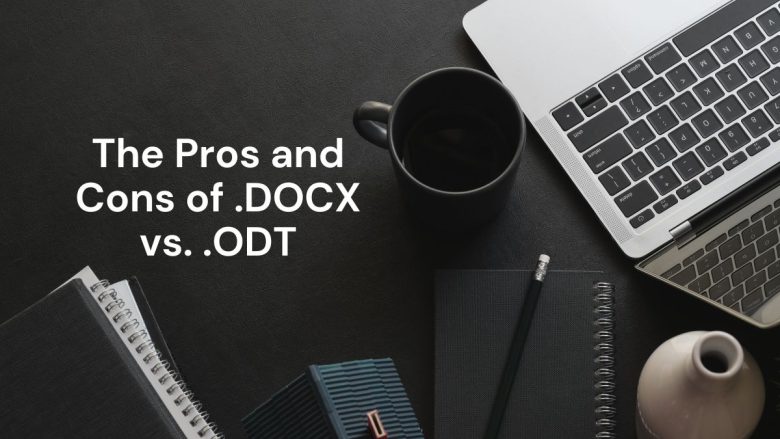
Today, in the digital age, creating and managing documents is key. They matter both at work and at home. Many file formats are available. .DOCX and .ODT are two of the most popular for word processing. Understanding each other’s pros and cons can help users. They can make informed choices based on their needs and preferences.
Introduction
Word processing documents are essential tools for creating, editing, and sharing written content. The .DOCX format was developed by Microsoft. It is widely recognized and used, especially in business. But the .ODT format is part of the Open Document Format (ODF) suite. It is an open standard favored by those who prefer open-source software. This blog post will look at the pros and cons of .DOCX and .ODT. It will provide a full comparison to help you choose the right format for your needs.
What is .DOCX?
.DOCX is the default file format used by Microsoft Word, part of the Microsoft Office suite. Introduced with Microsoft Word 2007, it replaced the older .DOC format. It offered better features and functions. .DOCX files use XML (Extensible Markup Language) to store data. This makes them more efficient and easier to recover if corrupted.
What is .ODT?
ODT stands for Open Document Text. Open-source word processors, like LibreOffice Writer and Apache OpenOffice Writer, use the ODT format. It is part of the Open Document Format (ODF), an open standard for document files. ODT files are also XML-based. This ensures they work well on different platforms and applications.
Pros of .DOCX
- Widespread Compatibility
- Integration with Microsoft Office: .DOCX is the native format for Microsoft Word, which is widely used in business and educational settings. This ensures that .DOCX files are highly compatible with other Microsoft Office applications, such as Excel and PowerPoint.
- Industry Standard: Due to its extensive use, .DOCX has become an industry standard. Most businesses, educational institutions, and organizations use Microsoft Word, making it easier to share and collaborate on .DOCX files.
- Advanced Features
- Formatting and Styles: Microsoft Word offers a rich set of formatting options, styles, and templates, allowing users to create professional-looking documents with ease.
- Collaboration Tools: .DOCX supports advanced collaboration features, such as track changes, comments, and real-time co-authoring, making it ideal for team projects and reviews.
- Integration with Other Tools
- Third-Party Applications: Many third-party applications and services offer integration with .DOCX, enhancing its functionality and usability. For example, tools like Grammarly and various document management systems are often designed to work seamlessly with .DOCX files.
- Cloud Services: Microsoft Word’s integration with cloud services like OneDrive and SharePoint allows for easy access, sharing, and collaboration on .DOCX documents from anywhere.
Cons of .DOCX
- Cost
- Microsoft Office Suite: To use .DOCX files to their full potential, users typically need to purchase a license for Microsoft Office, which can be expensive for individuals and organizations, especially those with limited budgets.
- Subscription Model: Microsoft’s shift to a subscription-based model (Office 365) means ongoing costs, which can be a disadvantage compared to one-time purchases of other software.
- Compatibility Issues
- Non-Microsoft Software: While .DOCX files can be opened in non-Microsoft word processors like LibreOffice Writer, formatting and feature compatibility issues may arise, leading to inconsistencies in document appearance and functionality.
- Older Versions: Users of older versions of Microsoft Word (pre-2007) may encounter difficulties opening and editing .DOCX files without compatibility packs or upgrades.
Read PDF to Word Converter online for free.
Pros of .ODT
- Open Source and Free
- No Cost: .ODT files can be created and edited using free, open-source word processors like LibreOffice Writer and Apache OpenOffice Writer. This makes it an attractive option for individuals, organizations, and educational institutions with budget constraints.
- Open Standard: As an open standard, .ODT is not tied to any specific software vendor, promoting interoperability and long-term accessibility.
- Cross-Platform Compatibility
- Multiple Platforms: .ODT files can be opened and edited on various operating systems, including Windows, macOS, Linux, and even some mobile platforms, using compatible word processors.
- Interoperability: The open nature of the ODF standard ensures better interoperability between different word processing applications, reducing the likelihood of compatibility issues.
- Customization and Flexibility
- Open Source Software: Users can customize and extend open-source word processors to suit their specific needs, adding plugins and features that enhance productivity and functionality.
- Community Support: The open-source community provides extensive support, with forums, documentation, and user-contributed plugins that help users get the most out of their software.
Cons of .ODT
- Limited Industry Adoption
- Less Widespread Use: .ODT is not as widely adopted as .DOCX, particularly in business environments. This can lead to compatibility issues when sharing documents with users who primarily use Microsoft Word.
- Perception Issues: There is a perception that open-source software is less reliable or professional, which can affect the acceptance and use of .ODT files in certain settings.
- Feature Limitations
- Advanced Features: While open-source word processors offer robust functionality, they may lack some of the advanced features and polish found in Microsoft Word. This can be a drawback for users who require specific tools for complex document creation and editing.
- User Interface: The user interface of open-source word processors may not be as intuitive or polished as Microsoft Word, potentially leading to a steeper learning curve for new users.
- Collaboration and Integration
- Limited Integration: .ODT files may not integrate as seamlessly with third-party applications and services compared to .DOCX. This can be a disadvantage for users who rely on specific tools for document management, proofreading, or cloud storage.
- Collaboration Features: While open-source word processors offer collaboration tools, they may not be as advanced or user-friendly as those in Microsoft Word, potentially hindering team-based projects.
Conclusion
The choice is between .DOCX and .ODT. It depends on cost, compatibility, features, and personal or organizational preferences. .DOCX is ideal for users. They need advanced features, and it works well with Microsoft Office. It also has extensive industry compatibility. However, it comes with a cost and potential compatibility issues with non-Microsoft software. ODT is a cost-effective, open-source alternative. It offers cross-platform compatibility and customization options. But, it may lack some advanced features and widespread use.
Ultimately, the decision should be based on your specific needs and workflow. By understanding the pros and cons of each format, you can make an informed choice. It will best suit your document creation and management needs.


